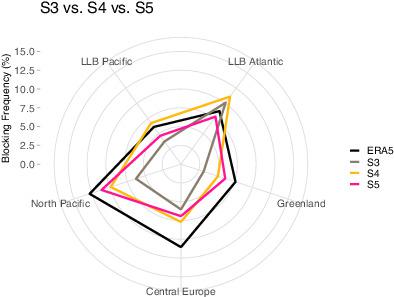当前位置:
X-MOL 学术
›
Q. J. R. Meteorol. Soc.
›
论文详情
Our official English website, www.x-mol.net, welcomes your feedback! (Note: you will need to create a separate account there.)
The representation of winter Northern Hemisphere atmospheric blocking in ECMWF seasonal prediction systems
Quarterly Journal of the Royal Meteorological Society ( IF 8.9 ) Pub Date : 2021-01-17 , DOI: 10.1002/qj.3974 Paolo Davini 1 , Antje Weisheimer 2, 3 , Magdalena Balmaseda 2 , Stephanie J. Johnson 2 , Franco Molteni 2 , Christopher D. Roberts 2 , Retish Senan 2 , Timothy N. Stockdale 2
Quarterly Journal of the Royal Meteorological Society ( IF 8.9 ) Pub Date : 2021-01-17 , DOI: 10.1002/qj.3974 Paolo Davini 1 , Antje Weisheimer 2, 3 , Magdalena Balmaseda 2 , Stephanie J. Johnson 2 , Franco Molteni 2 , Christopher D. Roberts 2 , Retish Senan 2 , Timothy N. Stockdale 2
Affiliation

|
The simulation and prediction of winter Northern Hemisphere atmospheric blocking in the seasonal prediction systems from the European Centre for Medium‐Range Weather Forecasts (ECMWF) is analysed. Blocking statistics from the operational November‐initialised seasonal hindcasts are evaluated in three generations of models: System3, System4, and System5 (SEAS5). Improvements in the climatological representation of blocking are observed in the most recent model configurations, with reduced bias over North Pacific and Greenland. Minor progress is seen over the European sector, where SEAS5 still underestimates the observed blocking frequency. SEAS5 blocking interannual variability is underestimated too and is proportional to the climatological frequency, highlighting that a negative bias in the blocking frequency implies an underestimation of the interannual variance. SEAS5 predictive skill and signal‐to‐noise ratio remain low, but interesting positive results are found over Western and Central Europe. Improved forecasts with reduced ensemble spread are obtained during El Niño years, especially at low latitudes. Complementary experiments show that the statistics of blocking are improved following atmospheric and oceanic resolution increase. Conversely, they remain largely insensitive to coupled model sea‐surface temperature (SST) errors. On the other hand, the implementation of stochastic parameterisations tends to displace blocking activity equatorward. Finally, by comparing seasonal hindcasts with climate runs using the same model, we highlight that the largest contributors to the chronic underestimation of blocking are persistent errors in the atmospheric model. It is also shown that SST errors have a larger impact on blocking bias in climate runs than in seasonal runs, and that increased ocean model resolution contributes to improved blocking more effectively in climate runs. Seasonal forecasts can thus be considered a suitable test‐bed for model development targeting blocking improvement in climate models.
中文翻译:

ECMWF季节预报系统中冬季北半球大气阻塞的表示
分析了欧洲中距离天气预报中心(ECMWF)在季节预测系统中对北半球冬季大气阻塞的模拟和预测。在三代模型中评估了11月份运营的季节性季节性后兆的阻塞统计量:System3,System4和System5(SEAS5)。在最新的模型配置中,观测到的阻塞的气候学表现有所改善,北太平洋和格陵兰的偏见有所减少。欧洲部门的进展较小,在该领域,SEAS5仍低估了观察到的阻塞频率。SEAS5阻止年际变化也被低估了,并且与气候频率成正比,强调阻塞频率的负偏差意味着对年际方差的低估。SEAS5的预测技能和信噪比仍然很低,但是在西欧和中欧发现了有趣的积极结果。在厄尔尼诺现象期间,尤其是在低纬度地区,获得了整体传播减少的改进预报。补充实验表明,随着大气和海洋分辨率的提高,阻塞的统计数据也得到了改善。相反,它们对耦合模型海表温度(SST)误差仍然不敏感。另一方面,随机参数化的实现倾向于使阻塞活动向赤道移动。最后,通过使用相同模型将季节性后兆与气候运行进行比较,我们强调指出,长期低估阻塞的最大原因是大气模型中的持续误差。还表明,与季节性运行相比,海表温度误差对气候运行的阻塞偏差影响更大,而海洋模型分辨率的提高有助于更有效地改善气候运行中的阻塞。因此,可以将季节性预报视为针对模型开发的合适试验平台,以阻止气候模型的改善为目标。
更新日期:2021-03-07
中文翻译:

ECMWF季节预报系统中冬季北半球大气阻塞的表示
分析了欧洲中距离天气预报中心(ECMWF)在季节预测系统中对北半球冬季大气阻塞的模拟和预测。在三代模型中评估了11月份运营的季节性季节性后兆的阻塞统计量:System3,System4和System5(SEAS5)。在最新的模型配置中,观测到的阻塞的气候学表现有所改善,北太平洋和格陵兰的偏见有所减少。欧洲部门的进展较小,在该领域,SEAS5仍低估了观察到的阻塞频率。SEAS5阻止年际变化也被低估了,并且与气候频率成正比,强调阻塞频率的负偏差意味着对年际方差的低估。SEAS5的预测技能和信噪比仍然很低,但是在西欧和中欧发现了有趣的积极结果。在厄尔尼诺现象期间,尤其是在低纬度地区,获得了整体传播减少的改进预报。补充实验表明,随着大气和海洋分辨率的提高,阻塞的统计数据也得到了改善。相反,它们对耦合模型海表温度(SST)误差仍然不敏感。另一方面,随机参数化的实现倾向于使阻塞活动向赤道移动。最后,通过使用相同模型将季节性后兆与气候运行进行比较,我们强调指出,长期低估阻塞的最大原因是大气模型中的持续误差。还表明,与季节性运行相比,海表温度误差对气候运行的阻塞偏差影响更大,而海洋模型分辨率的提高有助于更有效地改善气候运行中的阻塞。因此,可以将季节性预报视为针对模型开发的合适试验平台,以阻止气候模型的改善为目标。


























 京公网安备 11010802027423号
京公网安备 11010802027423号